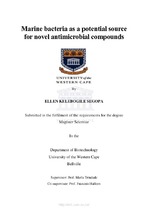| dc.description.abstract | The high rate of rediscovery of known compounds has led to a decline in the discovery of novel natural products. The high biodiversity of organisms growing in extreme conditions such as oceans has led to the increased interest by researchers for their use as a source of novel natural products. Marine bacteria are known for their extensive biosynthetic capacity to produce diverse natural products, which are suitable for various biotechnology applications such as in agriculture, for treatment of fungal plant pathogens, and as antibiotics, for treatment of bacterial infections.
This study aimed at discovering novel secondary metabolites from marine bacteria previously associated with novel marine invertebrate species endemic to the South African coast. The methodologies used in this study included a bioassay guided fractionation coupled to genome sequencing and mining. For the bioassay guided fractionation approach, the study first focused on screening marine bacteria for antimicrobial activity when cultured on 4 different media, against fungal strains previously shown to be virulent olive trunk pathogens. In parallel, the bacterial isolates with the most inhibitory activity against the fungal pathogens were also screened for antimicrobial activity against 4 indicator strains including Gram-negative Escherichia coli 1699 (E. coli), Pseudomonas putida, and Gram-positive Staphylococcus epidermidis ATCC14990, and Bacillus cereus ATCC10702. One of the marine bacterial isolates, PE6-126, showed diverse antimicrobial activity including antibacterial and antifungal activity against the tested strains.
The genome sequencing data revealed that this isolate was B. cereus based on the average nucleotide identity (ANI) (>99%) to reference strains. antiSMASH analysis of the genome revealed nine predicted secondary metabolite clusters including bacteriocins (2), non-ribosomal peptide synthetase (NRPS) (2), siderophore (1), sactipeptide (1), betalactone (1), linear azol(in)e-containing peptides (LAP) - bacteriocin (1) and a terpene (1). Some of these pathways had low to no sequence similarity to known pathways, indicating the potential of these pathways to produce novel compounds. One of the pathways showed very high sequence similarity to the thuricin CD pathway in Bacillus thuringiensis. Considering that thuricin CD has been reported to have antimicrobial activity against B. cereus (ATCC1072), it was hypothesised that it could also be produced by PE6-126. However, the antimicrobial extract from PE6-126 was tested for sensitivity to proteinase K and heat treatment, which thuricin CD is known to be sensitive to. The results revealed that the antimicrobial activity was not lost after treatment, implying that a different metabolite could be responsible for the anti-B. cereus activity. In addition, PE6-126 initially displayed antimicrobial activity against a multi-drug resistant E. coli 1699, suggesting some of the antimicrobial compound/(s) produced by this strain could potentially be novel. The bioassay-guided fractionation approach coupled to Liquid Chromatography Mass Spectrometry (LC-MS) did not lead to identification of the antimicrobial compound/(s), therefore it remains a question whether the secondary metabolite pathways predicted by antiSMASH lead to the production of the active compound/(s).
The results from this study showed that even well studied species have the potential to synthesize as yet undescribed compounds, based on the novelty of some of the pathways. This study highlights the importance of employing a genome-guided approach in drug discovery, as there may be many novel compounds to discover from biosynthetic pathways that have not yet been characterised. Further research is needed to identify the antimicrobial compound/(s) produced by PE6-126. | en_US |

